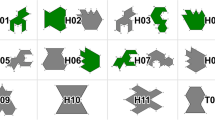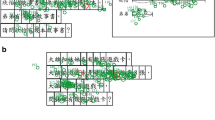Abstract
To analyze the impact of illustrations on solving mathematical word problems for primary school students, in this study we investigated systematically the functions of illustrations in terms of various presentations of texts and illustrations, and the difficulties associated with various learning materials. The characteristics of eye movement were studied with regard to the effect of split attention by using eye trackers. The results revealed the following: the presentation format of integrated texts and illustrations worked the best for problem solving under the condition of mathematical word problems with illustrations; the difficulty of the problem affected the role of illustrations; a high frequency of attention switching between texts and illustrations and longer fixation durations on the required picture provided evidence for the split attention effect using an eye-movement index. Based on these results, using more visual and verbal representations helps students solve mathematical word problems.






Similar content being viewed by others
References
Ahmad, A., Tarmizi, R. A., & Nawawi, M. (2010). Visual representations in mathematical word problem solving among form four students in Malacca. Procedia-Social and Behavioral Sciences, 8, 356–361.
Ayres, P., & Sweller, J. (2005). The split-attention principle in multimedia learning. The Cambridge Handbook of Multimedia Learning, 2, 135–146.
Berends, I. E., & Lieshout, E. (2009). The effect of illustrations in arithmetic problem-solving: Effects of increased cognitive load. Learning and Instruction, 19(4), 345–353.
Bobis, J., Sweller, J., & Cooper, M. (1994). Demands imposed on primary-school students by geometric models. Contemporary Educational Psychology, 19(1), 108–117.
Boonen, A. J., Van der Schoot, M., van Wesel, F., de Vries, M. H., & Jolles, J. (2013). What underlies successful word problem solving? A path analysis in sixth grade students. Contemporary Educational Psychology, 38(3), 271–279.
Boucheix, J., & Lowe, R. K. (2010). An eye tracking comparison of external pointing cues and internal continuous cues in learning with complex animations. Learning and Instruction, 20(2), 123–135.
Canham, M., & Hegarty, M. (2010). Effects of knowledge and display design on comprehension of complex pictureics. Learning and Instruction, 20(2), 155–166.
Chandler, P., & Sweller, J. (1992). The split-attention effect as a factor in the design of instruction. British Journal of Educational Psychology, 62(2), 233–246.
Cierniak, G., Scheiter, K., & Gerjets, P. (2009). Explaining the split-attention effect: Is the reduction of extraneous cognitive load accompanied by an increase in germane cognitive load? Computers in Human Behavior, 25(2), 315–324.
De Koning, B. O. R. B., Tabbers, H. K., Rikers, R. M., & Paas, F. (2010). Attention guidance in learning from a complex animation: Seeing is understanding? Learning and Instruction, 20(2), 111–122.
De Westelinck, K., Valcke, M., De Craene, B., & Kirschner, P. (2005). Multimedia learning in social sciences: Limitations of external pictureical representations. Computers in Human Behavior, 21(4), 555–573.
Dewolf, T., et al. (2004). The impact of illustrations and warnings on solving mathematical word problems realistically[J]. The Journal of Experimental Education, 82(1), 103–120.
Dewolf, T., Van Dooren, W., Hermens, F., & Verschaffel, L. (2014). Do students attend to representational illustrations of non-standard mathematical word problems, and if so, how helpful are they? Instructional Science, 43(1), 147–171.
Fan, L., Ngaiying, W., Cai, J., & Li, S. (2004). How Chinese learn mathematics (pp. 78–80). World Scientific.
Florax, M., & Ploetzner, R. (2010). What contributes to the split-attention effect? The role of text segmentation, picture labelling, and spatial proximity. Learning and Instruction, 20(3), 216–224.
Hollender, N., Hofmann, C., Deneke, M., & Schmitz, B. (2010). Integrating cognitive load theory and concepts of human–computer interaction. Computers in Human Behavior, 26(6), 1278–1288.
Jarodzka, H., Scheiter, K., Gerjets, P., & Van Gog, T. (2010). In the eyes of the beholder: How experts and novices interpret dynamic stimuli. Learning and Instruction, 20(2), 146–154.
Kester, L., Kirschner, P. A., & Merri Enboer, J. J. (2005). The management of cognitive load during complex cognitive skill acquisition by means of computer-simulated problem solving. British Journal of Educational Psychology, 75(1), 71–85.
Mayer, R. E. (2010). Unique contributions of eye-tracking research to the study of learning with pictureics. Learning and Instruction, 20(2), 167–171.
McCrudden, M. T., Magliano, J. P., & Schraw, G. (2011). The effect of diagrams on online reading processes and memory. Discourse Processes, 48(2), 69–92.
Mayer, R. E., & Sims, V. K. (1994). For whom is a picture worth a thousand words? Extensions of a dual-coding theory of multimedia learning. Journal of educational psychology, 86(3), 389. https://doi.org/10.1037/0022-0663.86.3.389.
Meyer, K., Rasch, T., & Schnotz, W. (2010). Effects of animation’s speed of presentation on perceptual processing and learning. Learning and Instruction, 20(2), 136–145.
Schmidt-Weigand, F., Kohnert, A., & Glowalla, U. (2010). A closer look at split visual attention in system-and self-paced instruction in multimedia learning. Learning and Instruction, 20(2), 100–110.
Schroeder, N. L., & Cenkci, A. T. (2018). Spatial contiguity and spatial split-attention effects in multimedia learning environments: A meta-analysis. Educational Psychology Review, 30(3), 679–701.
Schoenfeld, A. H. (1994). Reflections on doing and teaching mathematics Mathematical thinking and problem solving. pp 53–70.
Suwarsono, S. (1982). Visual imagery in the mathematical thinking of seventh grade students (Doctoral dissertation, Monash University).
Sweller, J., Ayres, P., & Kalyuga, S. (2011). The redundancy effect. Cognitive load theory (pp. 141–154). Springer.
Sweller, J., Van Merrienboer, J. J., & Paas, F. G. (1998). Cognitive architecture and instructional design. Educational Psychology Review, 10(3), 251–296.
Torcasio, S., & Sweller, J. (2010). The use of illustrations when learning to read: A cognitive load theory approach. Applied Cognitive Psychology, 24(5), 659–672.
Verschaffel, L., Schukajlow, S., Star, J., & Van Dooren, W. (2020). Word problems in mathematics education: A survey. ZDM Mathematics Education, 52(1), 1–16.
Yuchang, H., & Guiqin, R. (2003). Study on eye movements of viewing illustrations in new mathematics textbook of first grade primary school. Acta Psychologica Sinica (china), 35(6), 818–822.
Yun, T., & Jiliang, S. (2003). The Immediate processing study on different presenting manners and different difficult texts with picture. Psychological Exploration (china), 02, 26–29.
Author information
Authors and Affiliations
Corresponding author
Additional information
Publisher's Note
Springer Nature remains neutral with regard to jurisdictional claims in published maps and institutional affiliations.
Rights and permissions
About this article
Cite this article
Wang, X., Kang, W., Huang, L. et al. The impact of illustrations on solving mathematical word problems for Chinese primary school students: evidence for a split attention effect on eye-movement research. ZDM Mathematics Education 54, 555–567 (2022). https://doi.org/10.1007/s11858-022-01357-3
Accepted:
Published:
Issue Date:
DOI: https://doi.org/10.1007/s11858-022-01357-3




